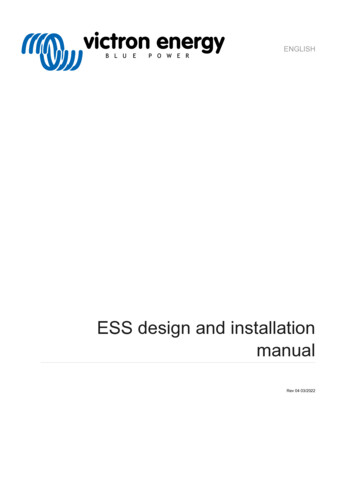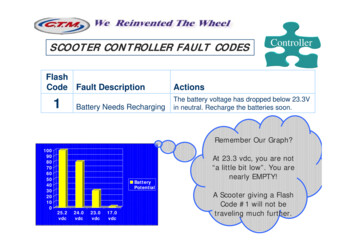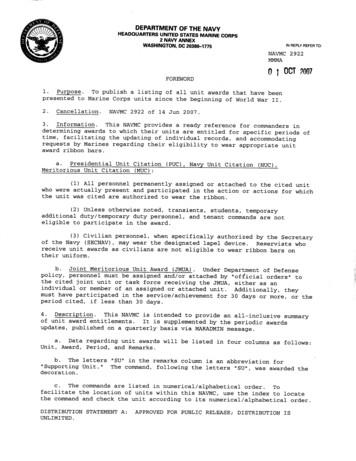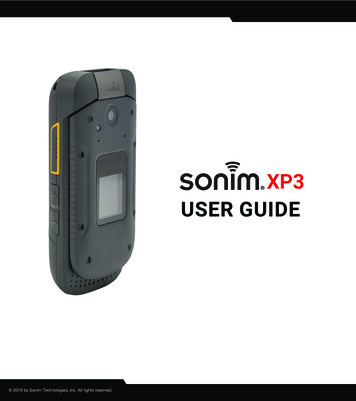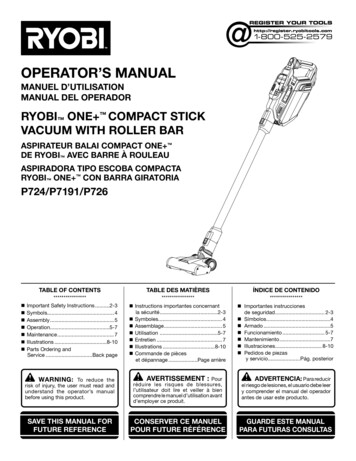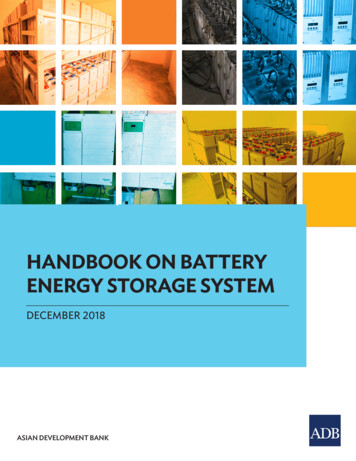
Transcription
HANDBOOK ON BATTERYENERGY STORAGE SYSTEMDECEMBER 2018ASIAN DEVELOPMENT BANK
HANDBOOK ON BATTERYENERGY STORAGE SYSTEMDECEMBER 2018ASIANDEVELOPMENTDEVELOPMENT BANKBANKASIAN
Creative Commons Attribution 3.0 IGO license (CC BY 3.0 IGO) 2018 Asian Development Bank6 ADB Avenue, Mandaluyong City, 1550 Metro Manila, PhilippinesTel 63 2 632 4444; Fax 63 2 636 2444www.adb.orgSome rights reserved. Published in 2018.ISBN 978-92-9261-470-6 (print), 978-92-9261-471-3 (electronic)Publication Stock No. TCS189791-2DOI: http://dx.doi.org/10.22617/TCS189791-2The views expressed in this publication are those of the authors and do not necessarily reflect the views and policiesof the Asian Development Bank (ADB) or its Board of Governors or the governments they represent.ADB does not guarantee the accuracy of the data included in this publication and accepts no responsibility for anyconsequence of their use. The mention of specific companies or products of manufacturers does not imply that theyare endorsed or recommended by ADB in preference to others of a similar nature that are not mentioned.By making any designation of or reference to a particular territory or geographic area, or by using the term “country”in this document, ADB does not intend to make any judgments as to the legal or other status of any territory or area.This work is available under the Creative Commons Attribution 3.0 IGO license (CC BY 3.0 o/. By using the content of this publication, you agree to be boundby the terms of this license. For attribution, translations, adaptations, and permissions, please read the provisionsand terms of use at https://www.adb.org/terms-use#openaccess.This CC license does not apply to non-ADB copyright materials in this publication. If the material is attributedto another source, please contact the copyright owner or publisher of that source for permission to reproduce it.ADB cannot be held liable for any claims that arise as a result of your use of the material.Please contact pubsmarketing@adb.org if you have questions or comments with respect to content, or if you wishto obtain copyright permission for your intended use that does not fall within these terms, or for permission to usethe ADB logo.Notes:In this publication, “ ” refers to United States dollars.ADB recognizes “Korea” as the Republic of Korea.On the cover: ADB Solar Mini Grid Pilot Project in Harkapur, Okhaldhunga, Nepal (Photo by C. Lao Torregosa);and, ADB solar-wind hybrid project site in Pira Kalwal and Wadgal Village, Joharabad, Khushab District, Pakistan(Photo by Nasr ur Rahman)Corrigenda to ADB publications may be found at http://www.adb.org/publications/corrigenda.
CONTENTSTable and Figures viForeword ixAcknowledgments xAbbreviations xiExecutive Summary 1Energy Storage Technologies 11.1 Storage Types 11.2 Components of a Battery Energy Storage System (BESS) 71.2.1 Energy Storage System Components 71.2.2 Grid Connection for Utility-Scale BESS Projects 91.3 Battery Chemistry Types 1.3.1 Lead–Acid (PbA) Battery 23xiii991.3.2 Nickel–Cadmium (Ni–Cd) Battery 101.3.3 Nickel–Metal Hydride (Ni–MH) Battery 111.3.4 Lithium-Ion (Li-Ion) Battery 111.3.5 Sodium–Sulfur (Na–S) Battery 131.3.6 Redox Flow Battery (RFB) 13Business Models for Energy Storage Services 152.1 Ownership Models 152.1.1 Third-Party Ownership 152.1.2 Outright Purchase and Full Ownership 162.1.3 Electric Cooperative Approach to Energy Storage Procurement 162.2 Factors Affecting the Viability of BESS Projects 172.3 Financial and Economic Analysis 182.3.1 Criteria for the Economic Analysis of BESS Projects 192.3.2 Key Assumptions in the Cost–Benefit Analysis of BESS Projects 19Grid Applications of Battery Energy Storage Systems 23iii
ivCONTENTS43.1 Scoping of BESS Use Cases 233.2 General Grid Applications of BESS 243.3 Technical Requirements 263.3.1 Round-Trip Efficiency 263.3.2 Response Time 263.3.3 Lifetime and Cycling 273.3.4 Sizing 273.4 Operation and Maintenance 283.5 Use Cases 283.5.1 Frequency Regulation 283.5.2 Renewable Energy Integration 303.5.3 Peak Shaving and Load Leveling 323.6 Microgrids 34Challenges and Risks 354.1 General Challenges 354.1.1 Cost Reduction 354.1.2 Deployment 364.1.3 Incentive Program 364.1.4 United Nations Framework Convention on Climate Change 374.2 General Risks 5384.2.1 Poorly Defined and Categorized Systems 384.2.2 Unbundling of Operation and Network Development Activities 384.2.3 Grid Tariff Applications and Licensing Issues 384.2.4 Battery Safety 394.3 Challenges of Reducing Carbon Emissions 404.4 Battery Recycling and Reuse Risks 424.4.1 Examples of Battery Reuse and Recycling 434.4.2 Reuse of Electric Vehicle Batteries for Energy Storage 464.4.3 Recycling Process 47Policy Recommendations 505.1 Frequency Regulation 505.2 Renewable Integration 50
Contents5.2.1 Distribution Grids 505.2.2 Transmission Grids 515.3 Peak Shaving and Load Leveling 525.4 Microgrids 52AppendixesASample Financial and Economic Analysis 53B Case Study of a Wind Power plus Energy Storage System Project in theRepublic of Korea 57CModeling and Simulation Tools for Analysis of Battery Energy Storage System Projects 60DBattery Energy Storage System Implementation Examples 61EBattery Chemistry 70FComparison of Technical Characteristics of Energy Storage System Applications 74GSummary of Grid Storage Technology Comparison Metrics 75v
TABLES AND FIGURESTables1.11.21.3Discharge Time and Energy-to-Power Ratio of Different Battery Technologies Advantages and Disadvantages of Lead–Acid Batteries Types of Lead-Acid Batteries 1.4 Uses of Lead–Acid Batteries 1.5 Advantages and Disadvantages of Nickel–Cadmium Batteries 1.6 Advantages and Disadvantages of Nickel–Metal Hydride Batteries 1.7 Advantages and Disadvantages of Lithium-Ion Batteries 1.8 Types of Lithium-Ion Batteries 1.9 Advantages and Disadvantages of Sodium–Sulfur Batteries 1.10 Advantages and Disadvantages of Redox Flow Batteries 1.11 Types of Vanadium Redox Batteries 2.1 Energy Storage Ownership Models 2.2 Key Factors Affecting the Viability of Battery Energy Storage System Projects 2.3 Comparison of Different Lithium-Ion Battery Chemistries 3.1 Energy Storage Use Case Applications, by Stakeholder 3.2 Technical Considerations for Grid Applications of Battery Energy Storage Systems 3.3 Sizing Methods for Power and Energy Applications 3.4 Operation and Maintenance of Battery Energy Storage Systems 4.1 Energy Storage Services and Emission Reduction A.1 Underlying Assumptions A.2 Capital Expenditure A.3 Operating Expenditure A.4 Revenue A.5 Financial Internal Rate of Return A.6 Calculation of Financial internal Rate of Return A.7 Calculation of Financial internal Rate of Return (University of Minnesota Energy Transition Lab, Strategen Consulting, and Vibrant Clean Energy 2017) B.1 Major Premises and Assumptions for Simple Levelized Cost of Electricity Estimations of Wind Power B.2 Comparison of Levelized Cost of Electricity for Wind Power Generation at Various Energy Storage System Operating Rates C.1 Available Modeling Tools D.1 Sokcho Substation, Republic of Korea - BESS Equipment Specifications D.2 Other Examples of BESS Application in Renewable Energy Integration 555758606165
Tables and FiguresFigures1.1Classification of Storage Technologies, by Energy Type 11.2 Different Technologies for Different Purposes 21.3 Comparison of Power Output (in watts) and Energy Consumption (in watt-hours) for Various 3Energy Storage Technologies 1.4 Differentiating Characteristics of Different Battery Technologies 41.5 Present and Future Battery Technologies 51.6 Grid Storage Needs along the Value Chain 51.7 Schematic of a Battery Energy Storage System 71.8 Schematic of a Utility-Scale Energy Storage System 81.9 Grid Connections of Utility-Scale Battery Energy Storage Systems 92.1 Stackable Value Streams for Battery Energy Storage System Projects 172.2 ADB Economic Analysis Framework 182.3 Expected Drop in Lithium-Ion Cell Prices over the Next Few Years ( /kWh) 192.4 Breakdown of Battery Cost, 2015–2020 202.5 Benchmark Capital Costs for a 1 MW/1 MWh Utility-Sale Energy Storage System Project 20(Real 2017 /kWh) 2.6 Benchmark Capital Costs for a 3 kW/7 kWh Residential Energy Storage System Project 21(Real 2017 /kWh) 2.7 Lifetime Curve of Lithium–Iron–Phosphate Batteries 223.1 Battery Energy Storage System Deployment across the Electrical Power System 233.2 Frequency Containment and Subsequent Restoration 293.3 Suitability of Batteries for Short Bursts of Power 293.4 Rise in Solar Energy Variance on Cloudy Days 303.5 Solar Photovoltaic installation with a Storage System 313.6 Illustration of Variability of Wind-Power Generation 313.7 Use of Energy Storage Systems for Peak Shaving 323.8 Use of Energy Storage Systems for Load Leveling 333.9 Microgrid on Jeju Island, Republic of Korea 344.1 Price Outlook for Various Energy Storage Systems and Technologies 354.2 Magnified Photos of Fires in Cells, Cell Strings, Modules, and Energy Storage Systems 404.3 Second-Life Process for Electric Vehicle Batteries 434.4 GM–ABB Second-Life Electric Vehicle Battery Applications 444.5 Second-Life Energy Storage Application for BMW Electric Vehicle Batteries 444.6 BMW–Bosch Second-Life Electric Vehicle Battery Demonstration Project 454.7 Renault–Powervault’s Second-Life Electric Vehicle Battery Application 454.8 Nissan–Sumitomo Electric Vehicle Battery Reuse Application (4R Energy) 464.9 Reuse of Electric Vehicle Batteries in Energy Storage Systems 464.10 Second-Life Electric Vehicle Battery Applications 474.11 Lithium-Ion Battery Recycling Process 484.12 Chemical Recycling of Lithium Batteries, and the Resulting Materials 484.13 Physical Recycling of Lithium Batteries, and the Resulting Materials 49vii
viiiTABLES AND E.1E.2E.3E.4E.5E.6E.7Sokcho Single Line Diagram Sokcho Site Plan Bird’s Eye View of Sokcho Battery Energy Storage System Sokcho Battery Energy Storage System BESS Application in Renewable Energy Integration 10 MW Yeongam Solar Photovoltaic Park, Republic of Korea Peak Shaving at Douzone Office Building, Republic of Korea Douzone Office Building System Diagram and CCTV Screen Capture Graphical Illustration of Peak Shaving at Duozone Office Building Black Start Capability First Microgrid System on Gapa Island Sendai Microgrid Project System Configuration of Microgrid on Gapa Island Lead-Acid Battery Schematic and Physical Structure Chemical and Physical Structures of Nickel-Cadmium Battery Chemical and Physical Structures of Nickel-Metal Hydride Battery Physical and Chemical Structures of Lithium-Ion Battery Chemical and Physical Structures of Sodium-Sulfur Battery Schematic of Redox Flow Battery Physical Structure of Redox Flow Battery 6162626363646666676868696970707171727373
FOREWORDThis Handbook on Battery Energy Storage Systems is part of a series of reference materials on advancedtechnologies. The objectives of this series are to support the Asian Development Bank (ADB)operations in adopting and deploying advanced technologies in energy projects for its developingmember countries, scale up the ADB Clean Energy Program, and bring the energy sector closer toachieving its targets in climate finance.This handbook outlines the various battery energy storage technologies, their application, and thecaveats to consider in their development. It discusses the economic as well financial aspects of batteryenergy storage system projects, and provides examples from around the world. The handbook also laysdown the policy requirements that will allow battery energy storage system development to thrive.Energy-related carbon dioxide emissions increased by 1.7% in 2018 to a historic high of 33.1 gigatons ofcarbon dioxide—with the power sector accounting for almost two-thirds of the growth in emissions.Additional capacity from renewables on the other hand, declined in 2018 after 2 decades of sustainedgrowth. These do not bode well and call for bigger and bolder efforts to fight climate change. Weneed to grab every opportunity to innovate and apply the most effective intervention at the quickestpossible time.As this handbook will show, battery energy storage systems fulfill objectives that generate multiplebenefits: integration of variable renewables, improvement in energy efficiency, reliability of electricitysupply, and access to and security of energy. Battery energy storage systems have a critical role intransforming energy systems that will be clean, efficient, and sustainable. May this handbook serve as ahelpful reference for ADB operations and its developing member countries as we collectively face thedaunting task at hand.Yongping ZhaiChief of Energy Sector GroupSustainable Development and Climate Change DepartmentAsian Development Bankix
ACKNOWLEDGMENTSThe Handbook on Battery Energy Storage System is an output of a comprehensive study carried outby the Sustainable Development and Climate Change Department of the Asian Development Bank(ADB) under Promoting Sustainable Energy for All in Asia and the Pacific – Renewable EnergyMinigrids and Distributed Power Generation (Subproject A). The study was conducted by a team inthe Sector Advisory Service Cluster–Energy Sector Group (SDSC-ENE) led by Dae Kyeong Kim, SeniorEnergy Specialist (Smart Grids), under the overall guidance of Robert Guild, Chief Sector Officer, andYongping Zhai, Chief of the Energy Sector Group. Two international experts were also part of the teamand made invaluable contributions in their capacities as authors of background papers.This handbook was written by: Dae Kyeong Kim, Senior Energy Specialist (Smart Grids), SDCC;Susumu Yoneoka, Energy Specialist (Smart Grids), SDCC; Ali Zain Banatwala (Consultant); and YuTack Kim (Consultant). Kee-Yung Nam, Principal Energy Economist, SDCC, reviewed the publicationstructure. Charity L. Torregosa, senior energy officer, coordinated the production and worked withMary Ann Asico (editor), Edith Creus (cover designer and lay-out artist), Jess Macasaet (proofreader),Cynthia A. Hidalgo and April-Marie D. Gallega from the Department of Communications. Staffsupport was also provided by Ana Maria Tolentino, Angelica Apilado, and Maria Dona Aliboso.The authors would like to extend their gratitude to other colleagues who provided comments, inputs,insights from operations, namely: Andrew Jeffries, James Kolantharaj, and Tianhua Luo.x
ABBREVIATIONSAC–alternating currentACB–air circuit breakerBESS–battery energy storage systemBMS–battery management systemCAES–compressed air energy storageCB–circuit breakerC&I–commercial and industrialCOD–commercial operation dateDLC–double-layer capacitorEFR–enhanced frequency responseEIS–electric insulation switchgearEMS–energy management systemEPC–engineering, procurement, and constructionESCO–energy service companyESS–energy storage systemEV–electric vehicleFES–flywheel energy storageGIS–gas insulation switchgearHSCB–high-speed circuit breakerIGBT–insulated gate bipolar transistorsxi
xiiABBREVIATIONSIPP–independent power d–acidLCOS–levelized cost of energy um–manganese oxideLPMS–local power management systemLSE–load-serving ickel–cobalt–aluminum oxidePCC–point of common couplingPCS–power conversion systemPMS–power management systemPV–photovoltaicSCS–supervisory control systemSOC–state of chargeSOH–state of heathUPS–uninterruptible power supplyVRFB–vanadium redox flow batteryVRLA–valve-regulated lead–acidW–wattZBFB–zinc–bromine flow battery
EXECUTIVE SUMMARYThis handbook serves as a guide to the applications, technologies, business models, and regulations thatshould be considered when evaluating the feasibility of a battery energy storage system (BESS) project.Several applications and use cases, including frequency regulation, renewable integration, peak shaving,microgrids, and black start capability, are explored. For example, the integration of distributed energyresources into traditional unidirectional electric power systems is challenging because of the increasedcomplexity of maintaining system reliability despite the variable and intermittent nature of wind and solarpower generation, or keeping customer tariffs affordable while investing in network expansion, advancedmetering infrastructure, and other smart grid technologies.The key to overcoming such challenges is to increase power system flexibility so that the occasionalperiods of excessive renewable power generation need not be curtailed or so that there is less need forlarge investments in network expansion that lead to high consumer prices. Storage offers one possiblesource of flexibility.Batteries have already proven to be a commercially viable energy storage technology. BESSs are modularsystems that can be deployed in standard shipping containers. Until recently, high costs and low roundtrip efficiencies prevented the mass deployment of battery energy storage systems. However, increaseduse of lithium-ion batteries in consumer electronics and electric vehicles has led to an expansion in globalmanufacturing capacity, resulting in a significant cost decrease that is expected to continue over the nextfew years. The low cost and high efficiency of lithium-ion batteries has been instrumental in a wave ofBESS deployments in recent years for both small-scale, behind-the-meter installations and large-scale,grid-level deployments. This handbook breaks down the BESS into its critical components and provides abasis for estimating the costs of future BESS projects.For example, battery energy storage systems can be used to overcome several challenges related tolarge-scale grid integration of renewables. First, batteries are technically better suited to frequencyregulation than the traditional spinning reserve from power plants. Second, batteries provide a costeffective alternative to network expansion for reducing curtailment of wind and solar power generation.Similarly, batteries enable consumer peak charge avoidance by supplying off-grid energy during on-gridpeak consumption hours. Third, as renewable power generation often does not coincide with electricitydemand, surplus power should be either curtailed or exported. Surplus power can instead be stored inbatteries for consumption later when renewable power generation is low and electricity demand increases.The financial viability of a BESS project for renewable integration will depend on the cost–benefit analysisof the intended application.The business case for battery energy storage differs by application and by use case. “Prosumers”(producers–consumers) can calculate the payback period of a home energy storage system from thespread between the cost of producing and storing rooftop solar power and the cost of purchasingelectricity from the local utility. Industrial consumers and distribution network owners benefit from axiii
xivEXECUTIVE SUMMARYreduction in peak capacity charges and network expansion deferral because of peak shaving and loadleveling. The business case for using batteries for frequency regulation depends on revenue forecastsand competition for ancillary services.Various business models are possible, depending on how ownership and operations responsibilityis divided between utility customers or prosumers and the utility or network operator. For example,while the charge and discharge cycles of home energy storage systems are set by the home ownersthemselves, industrial battery systems could be operated by a demand-side management provider orflexibility aggregator. Similarly, while large-scale batteries used for frequency regulation may be ownedby private investors, the operation of such systems is likely to be the responsibility of the transmissionsystem operator as part of the pool of assets that provide spinning reserve.This handbook lists the major policy and regulatory changes that could help promote energy storagemarkets and projects. For example, in most countries that operate ancillary service markets, frequencyregulation products have historically been designed with the technical limitations of large powerstations in mind. However, in 2016, a new ancillary service known as “enhanced frequency response,”with a sub-second response time that could be met only with the help of batteries, was launched inEurope. Similarly, in some countries, the provision of frequency regulation is mandatory for developersof large wind farms, to reduce the need for increased spinning reserve from conventional power plants.As with most projects, it is important to capture the risks and challenges in undertaking a typicalbattery energy storage project. This handbook outlines the most important risks and challenges from aproject execution perspective. It also provides a guide for building a financial model for BESS projects,including popular investment metrics such as the levelized cost of storage.
1ENERGY STORAGE TECHNOLOGIESThis chapter provides an overview of commonly used energy storage technologies. It looks into variousfactors that differentiate storage technologies, such as cost, cycle life, energy density, efficiency, poweroutput, and discharge duration.One energy storage technology in particular, the battery energy storage system (BESS), is studied ingreater detail together with the various components required for grid-scale operation. The advantagesand disadvantages of different commercially mature battery chemistries are examined. The chapterends with a review of best practice for recycling and reuse lithium-ion batteries.1.1STORAGE TYPESEnergy storage devices can be categorized as mechanical, electrochemical, chemical, electrical, orthermal devices, depending on the storage technology used (Figure 1.1). Mechanical technology,including pumped hydropower generation, is the oldest technology. However, a limitation of thistechnology is its need for abundant water resources and a different geographic elevation, as wellas the construction of power transmission lines to households that consume electricity. Recently,transmission-line construction cost has surpassed the cost of installing a pumped hydropowergeneration facility.Figure 1.1: Classification of Storage Technologies, By Energy Type*Mechanical, electrochemical, chemical, electrical, or thermal.Li-ion lithium-ion, Na–S sodium–sulfur, Ni–CD nickel–cadmium, Ni–MH nickel–metal hydride, SMES superconductingmagnetic energy storage.Source: Korea Battery Industry Association 2017 “Energy storage system technology and business model”.1
HANDBOOK ON BATTERY ENERGY STORAGE SYSTEMIn addition to the recent spread of mobile information technology (IT) devices and electric vehicles,the increased mass production of lithium secondary batteries and their lowered costs have boosteddemand for energy storage devices using such batteries. Lithium secondary batteries convert electricenergy to chemical energy, and vice versa, using electrochemical technologies. Such technologies alsoinclude lead storage batteries and sodium–sulfur batteries. Chemical technologies include energystorage technologies such as fuel cells, and mechanical technologies include electric double-layercapacitors.The performance of energy storage devices can be defined by their output and energy density.Their use can be differentiated by place and duration of use, as defined by the technology adopted.In Figure 1.2, the applications (in the tan-colored boxes) are classified according to output, usageperiod, and power requirement, and the energy storage devices (in the amber-colored boxes)according to usage period, power generation, and system and/or network operation.Figure 1.2: Different Technologies for Different PurposesSeasonalstorageT&D deferral1) Small-scale 2) Large-scale 3) icro-secondSeasonEnd userWeekDayMinuteSecondMicro-second1 kWHourOffscale/enduserselfcons.Hour10 elsSS1) windPV: gridsupportCompressed airenergy storage(CAES)GenerationP2G3)Batteries100 kWPumped hydrostorage (PHS)Supercapacitors1 MWBlack startVoltage regulation10 GWLoad followingLS2) windPV: gridsupport100 GW0 kWArbitrage1 GWInter-seasonalstorage10 GWFrequency regulationPower requirement2Discharge durationTechnologyGW gigawatt, kW kilowatt, MW megawatt, P2G power to gas, PV photovoltaic, SS small-scale, T&D transmissionand distribution.Source: ROLAND BERGER GMBH (2017). R. Berger, “Business models in energy storage – Energy Storage can bring utilities backinto the game,” May.
Energy Storage TechnologiesEnergy storage devices can be used for uninterruptible power supply (UPS), transmission anddistribution (T&D) system support, or large-scale generation, depending on the technology appliedand on storage capacity. Among electrochemical, chemical, and physical energy storage devices, thetechnologies that have received the most attention recently fall within the scope of UPS and T&Dsystem support (Figure 1.3). Representative technologies include reduction–oxidation (redox) flow,sodium–sulfur (Na–S), lead–acid and advanced lead–acid, super-capacitor, lithium, and flywheelbatteries. Lithium batteries are in common use today.Figure 1.3: Comparison of Power Output (in watts) and Energy Consumption (in watt-hours)for Various Energy Storage TechnologiesBulk PowerManagementHoursT&D Supportingand Load ShiftingFlow BatteryZn-Cl, Zn-Br, VNaS BatteryAdvanced Lead-Acid BatterySupercapacitorMinutesLithium BatteryLead-Acid BatteryFlywheelSecondsDischarge Time at Rated PowerUPSPower QualitySupercapacitor (Power)1kW10kW100kW1MW10MW100MW1GWSystem Power Ratings, Module SizeGW gigawatt, kW kilowatt, MW megawatt, T&D transmission and distribution, UPS uninterruptible power supply,V vanadium, Zn–Br zinc–bromine, Zn–Cl zinc–chlorine.Note: With nominal discharge time ranging from seconds to hours. Both power output and energy consumption are expressed inlogarithmic scales.Source: Korea Battery Industry Association 2017 “Energy storage system technology and business model”.Battery technologies for energy storage devices can be differentiated on the basis of energy density,charge and discharge (round trip) efficiency, life span, and eco-friendliness of the devices (Figure 1.4).Energy density is defined as the amount of energy that can be stored in a single system per unit volumeor per unit weight. Lithium secondary batteries store 150–250 watt-hours per kilogram (kg) and canstore 1.5–2 times more energy than Na–S batteries, two to three times more than redox flow batteries,and about five times more than lead storage batteries.Charge and discharge efficiency is a performance scale that can be used to assess battery efficiency.Lithium secondary batteries have the highest charge and discharge efficiency, at 95%, while leadstorage batteries are at about 60%–70%, and redox flow batteries, at about 70%–75%.3
4HANDBOOK ON BATTERY ENERGY STORAGE SYSTEMOne important performance element of energy storage devices is their life span, and this factor has thebiggest impact in reviewing economic efficiency. Another major consideration is eco-friendliness, orthe extent to which the devices are environmentally harmless and recyclable.Figure 1.4: Differentiating Characteristics of Different Battery TechnologiesLi-ionNaSFlowNi-CdLeadLead AcidAcidEnergy oNoLi-ion lithium-ion, Na–S sodium–sulfur, Ni–Cd nickel–cadmium.Source: Korea Battery Industry Association 2017 “Energy storage system technology and business model”.Technological changes in batteries are progressing toward higher energy density (Figure 1.5). Nextgeneration battery technologies—lithium-ion, zinc–air, lithium–sulfur, lithium–air, etc.—are expectedto improve on the energy density of lithium secondary (rechargeable) batteries, and be priced below 50 per kilowatt (kW).Energy storage device applications vary depending on the time needed to connect to the generator,transmitter, and place of use of energy, and on energy use. Black start, a technology for restartinggenerators after blackouts without relying on the external power grid, is installed in the generatingbus and supplies energy within 15–30 minutes. Power supply for maintaining frequency is providedwithin a quarter-hour to an hour of system operation. Power supply for maintaining voltage level isprovided within a shorter operating interval. Grid storage needs are categorized in Figure 1.6 accordingto network function, power market, and duration of use. Table 1.1 compares the various batterytechnologies according to discharge time and energy-to-power ratio.
Energy Storage TechnologiesFigure 1.5: Present and Future Battery TechnologiesEnergy density 00Li-ionFutureLi-ionZn-air300 150 150Price /kWh200AvailableLi-S 150Under developmentLi-air 150R&DLi–air lithium–air, Li-ion lithium ion, Li–S lithium–sulfur, Ni–Cd nickel–cadmium, Ni–MH nickel–metal hydride, Pb–acid lead–acid, Zn–air zinc–air.Source: Second Life-Batteries as Flexible Storage for Renewables Energies, 2016Figure 1.6: Grid Storage Needs along the Value ChainDuration of need todeal with ketparticipantsEnd usersCorrectionof econds to min
CSONTENT v 5.2.1 istribution Grids D 50 5.2.2 ransmission Grids T 51 5.3eak Shaving and Load Leveling P 52 5.4 Microgrids





